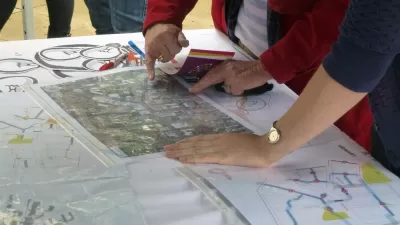A bit of a redefining moment is happening among European planners as they look for ways to address the growing complexity of their communities and the world.
"Call it post-planning, planning 2.0, or maybe un-planning. And the crazy thing is, this revolt against traditional approaches to planning is being conducted by planners themselves," writes Anthony Flint to introduce a recent article about the "identity crisis" in contemporary planning.
Flint's discussion of the evolution of planning follows his attendance of the annual Association of European Schools of Planning conference, where "there was no little soul-searching about the practice of the craft." Rather, Flint writes, planners there were wondering whether, "despite the grand efforts, planning wasn’t really paying off."
As for why: "Global urbanization carries multiple complexities, with loads of unintended consequences and unanticipated outcomes, whether in Cleveland or London or Bogota. If the future is not linear, planning in a linear fashion is the equivalent of banging one’s head against the drafting table."
The article focuses on the exchange of ideas between European planning and American planning, which, already complicated by American political concerns about socialism and Agenda 21 fear mongering, could now be further complicated by European rejection of Smart Growth and other ideas exported by continental planers. According to Flint, "smart growth, whether urban growth boundaries or compact transit-oriented development, is essentially European. And now the Europeans are saying the command-and-control approach doesn’t work so well. European nations are actually adopting more of an American stance—a decentralized agenda, pushing down remaining responsibilities to local jurisdictions, and counting on local planners to engage the citizenry much more."
The article goes on to describe a future for planning, advocated by attendees at the event, that will allow for complexity and evolution in a more complex and connected world.
FULL STORY: Is Urban Planning Having an Identity Crisis?

Alabama: Trump Terminates Settlements for Black Communities Harmed By Raw Sewage
Trump deemed the landmark civil rights agreement “illegal DEI and environmental justice policy.”

Planetizen Federal Action Tracker
A weekly monitor of how Trump’s orders and actions are impacting planners and planning in America.

The 120 Year Old Tiny Home Villages That Sheltered San Francisco’s Earthquake Refugees
More than a century ago, San Francisco mobilized to house thousands of residents displaced by the 1906 earthquake. Could their strategy offer a model for the present?

Indy Neighborhood Group Builds Temporary Multi-Use Path
Community members, aided in part by funding from the city, repurposed a vehicle lane to create a protected bike and pedestrian path for the summer season.

Congestion Pricing Drops Holland Tunnel Delays by 65 Percent
New York City’s contentious tolling program has yielded improved traffic and roughly $100 million in revenue for the MTA.

In Both Crashes and Crime, Public Transportation is Far Safer than Driving
Contrary to popular assumptions, public transportation has far lower crash and crime rates than automobile travel. For safer communities, improve and encourage transit travel.
Urban Design for Planners 1: Software Tools
This six-course series explores essential urban design concepts using open source software and equips planners with the tools they need to participate fully in the urban design process.
Planning for Universal Design
Learn the tools for implementing Universal Design in planning regulations.
Clanton & Associates, Inc.
Jessamine County Fiscal Court
Institute for Housing and Urban Development Studies (IHS)
City of Grandview
Harvard GSD Executive Education
Toledo-Lucas County Plan Commissions
Salt Lake City
NYU Wagner Graduate School of Public Service





























